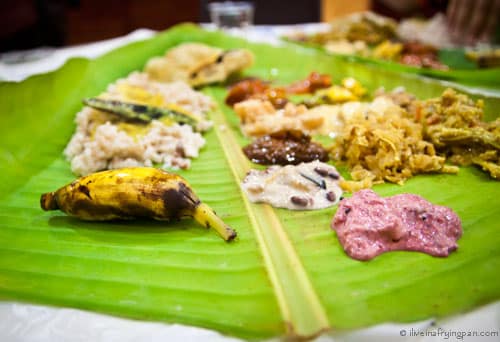Celebrate Onam with Us Over a Traditional Sadhya Feast
This September 15, 2024, celebrate the harvest festival of Onam the way Keralites do in the South Indian state, with a traditional banana leaf meal — sadhya! At Frying Pan Adventures, we love to plan seasonal meet ups to bring our community together over a fun and casual meal of deep cultural value. This all-vegetarian feast will feature 33 items and is an incredible sensory overload.
Meet ups tickets can only be unlocked by VIP Pass members. If you haven’t got your free VIP Pass yet, try to beat the queue and sign up for one now. We cannot wait to share this experience with you!
Where to Try Sadhya
Every Onam, Keralite restaurants all across Dubai offer sadhya lunch for a few days both as dine-in and takeaway. Many take prior bookings while others have a waiting queue at the restaurant. Call in advance to find out how to secure your sadhya to avoid disappointment!
Here are a few to look up if you’re looking for an Onam sadhya in 2024 (we’ve tried and enjoyed the first two on this list):
| Restaurant | Location | Price (AED) | Date(s) | Special Notes |
|---|---|---|---|---|
| Golden Sands | Bur Dubai | 35 | Sep 13 to 16 | |
| Aaraamam | Multiple locations | 40 | Sep 15 | |
| Kalpaka | Karama | 40 | Sep 14 to 15 | |
| Kayaloram | Karama | 40 | Sep 15 | |
| Mami’s Illam | Discovery Gardens | 45 | Sep 13 to 15 | |
| Nalakettu | Qusais | 45 | Sep 13 to15 | |
| Calicut Paragon | Multiple locations | 46 | Sep 13 to 15 | |
| Adaminde Chayakada | Multiple locations | 46 | Sep 14 to 15 | |
| Dhe Puttu | Karama | 46 | Sep 13 to 16 | Sep 15 only home delivery |
| Calicut Notebook | Multiple locations | 48 | Sep 15 | |
| Salkara | Multiple locations | 48 | Sep 15 | Takeout only |
| Bombay Borough | DIFC | 165 | Sep 13 to 15 | |
| The Crossing | H Hotel | 175 | Sep 6 to 15 | 12PM to 10PM |
| Varq at Taj Exotica | The Palm, Dubai | 295 | Sep 14 to 15 | 12PM to 3PM |
| The Pepper Lane | Dubai Silicon Oasis | 0 | Sep 14 to 15 | Price TBD |
Learn More: What is Onam?
The following article is adapted from an article written by our co-founder, Arva, for the Friday magazine in 2017.
Onam is a harvest festival celebrated every year by Malayali communities, regardless of their religious faith, across Kerala. It commemorates the rice harvest season towards the tail end of the monsoon and ushers in the month of Chingam, the first month of the Malayali New Year. The festival is ripe with legends, the most common of which describes the annual homecoming of the demon king Mahabali from the netherworld.
Like most cultural festivals around the world, Onam is marked with a feast called “sadhya.” This is an extravagant meal featuring over twenty different vegetarian items methodically placed across the ribs of a shiny banana leaf. If you fail to bag an invite from one of our many Malayali friends in the local resident community, then elbow your way into the lunch queues outside any of the Keralite restaurants serving Onam sadhya in Karama. And resolve to make more Malayali friends who will invite you home for sadhya next year.
Feasting with Hands
Fork and knife-wielding cultures often perceive those that feast with their hands as being primitive and uncultured—but there is a delicate choreography and etiquette around serving and savoring such meals that makes it no less than one orchestrated with fine silver. For instance, when the meal is over, you must fold your banana leaf over. If you fold it facing yourself, it expresses contentment, while folding it the other way expresses the opposite.
Navigating the sadhya
If like me, you are an amateur still fumbling with the nuances of sadhya etiquette, then do the most polite thing possible when the meal starts—pounce on the banana chips to the left of your leaf and keep your eyes glued to a more practiced fellow diner. There are two types of fried bananas to keep you going as you watch how others navigate the meal: the sunny-hued savoury crisps and the sweet “sharkara varatti” or banana pellets coated in crumbly jaggery sugar. Restrain yourself from stealing sharkara varatti from the fellow diner next to you, unless the fellow diner is a very good friend who is allergic to bananas or is willing to forgive and forget.
Abandon a few of the pappadums and the midget banana on the left until dessert time. I say this with a slight tinge of pain because I only recently realized that for the past three years, I have failed to apply them in the meal as the experts would. Instead, stay focused on the pickles and the rainbow of dry, semi-dry and wet dishes that you will need to eat with your fingers.
Contrary to my usual inquisitive nature, I no longer over-analyze every item on the banana leaf because it gets in the way of having a deeply immersive and sensory experience. Especially if it is your first sadhya this year, just hold the questions and let the wave of textures and flavours carry you through the meal: soft, crunchy, pulpy, slippery, banana, coconut and yogurt.
The broker for the various players on the leaf is “chor” or reddish Matta rice from Kerala. Chor is served closer to your side of the leaf with two soupy lentils doused on either side of the plateau of rice—creamy coconut-infused “parippu” to the left and a slightly sour, spicy tamarind-based “sambar” to the right. The chubby grains are sponges for soaking up melted ghee, gravies and lentils. Form them into little mounds with your fingers before swiping them off the leaf and into your mouth. If you have never eaten rice with your hands, don’t be afraid of the messy challenge but relish the additional sensory dimension of touching the food with your (rigorously washed) fingers instead. The technique is nothing that cannot be mastered with a joint dose of practice and gluttony.
And what about the untouched baby banana and the residual pappadums? They play a role when a sweet, runny “payasam” pudding of coconut, lentils and jaggery are streamed onto your leaf (cups are for novices). I do not need to tell you how to use them—one of the city’s best cultural and culinary lessons unfolds across Keralite homes and restaurants every Onam, and you only need an appetite to study it.
Hunt down a sadhya and watch the masters at feast.

Arva Ahmed is the co-founder of Frying Pan Adventures, Dubai’s first food tour company, and a celebrated food explorer known for uncovering Dubai’s hidden culinary gems. Her expertise in the city’s diverse food scene has been featured in prominent publications such as CNN, Khaleej Times, BBC Travel, The Sun, The Independent and countless more. She also hosts Ditch the Silver on YouTube. Through her immersive tours and storytelling, Arva brings Dubai’s rich flavors and vibrant cultures to life.




